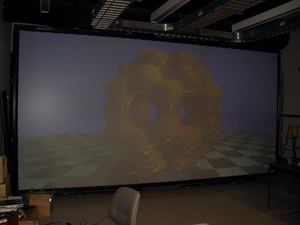 The tiled display wall in IDAV's Virtual Reality Lab.
The tiled display wall in IDAV's Virtual Reality Lab.
| Website |
| IDAV.UCDavis.edu |
The Institute for Data Analysis and Visualization or IDAV (formerly known as CIPIC) is actually not just the graphics group as many people first think, but rather a research unit that encompasses several different groups.
The graphics groups (website):
- The "main" lab. This is where the majority of the students (undergrad, grad, and post-doc) work. The main professors for this lab are Ken Joy, Bernd Hamann, Kwan-Liu Ma, Nelson Max and John Owens.
- The computation geometry lab (a.k.a. Nina's lab). The students working in this lab work mainly with Nina Amenta on computation geometry related research.
- The virtual reality lab (a.k.a. Oliver's lab, a.k.a siberia). The students working in this lab are working primarily with Oliver Staadt on virtual reality related research.
The interface group (website):
This group is primarily working on sound related research, and has done much of the pioneering work in spatial audio techniques. Chances are, if you've played a computer game with 3D sound, you may have used some of their research. Incidentally, unlike much of IDAV, this group isn't located in Academic Surge, but rather in a building downtown (the same building in which Hunan is located). The primary researchers in this group are Ralph Algazi, Richard Duda and Dennis Thompson.
The bioinformatics group (website):
As the name would imply, this group is working in bioinformatics. Their focus is on gene expression, proteins, and cell metabolism. The primary researchers are David Bunch, Zelanna Goldberg, Kyoungmi Kim, Hongzhe Li, David Rocke and David Woodruff. I'm not as familiar with this group as with the others. Perhaps someone more knowledgeable than me could fill in some info here. - EricKlein
Virtual Reality Lab
The first thing people always notice in the VR lab (and how could you not?) are the big toys.... um, I mean the VR equiment.
We have two primary VR environments.
-
The 'Big Wall'. Our newest setup is a 18x9 tiled wall. The wall is made up of 6 tiles (3 across, and 2 down). Each tile has a resolution of 1024x768 pixels, and each tile has 3D stereo vision support (using active projection). Additionally, the wall has head tracking for the main user, and a tracked control wand to interact with the virtual environment. The end result is absolutely amazing. We are currently working to add support for spatial audio as well (using position tracked headphones).
-
In order to get 3D images (i.e. stereo images), each tile has two projectors behind it, shuttered to alternate images (at about 60 hertz per eye) for each eye. The user then uses shuttered glasses synchronized with the projector shutters.
-
In theory, this wall should be awesome for watching movies. In practice, well... that would be irresponsible. The wall is for serious research....
The workbench. This is our original virtual environment. It also supports 3D stereo images, however it uses a single display (a massive CRT projector, that originally cost a shockingly large amount), and the screen is more horizontal than vertical. It also has head tracking and a wand. In addition, it uses tracked gloves, and the gloves add a button to each finger.



